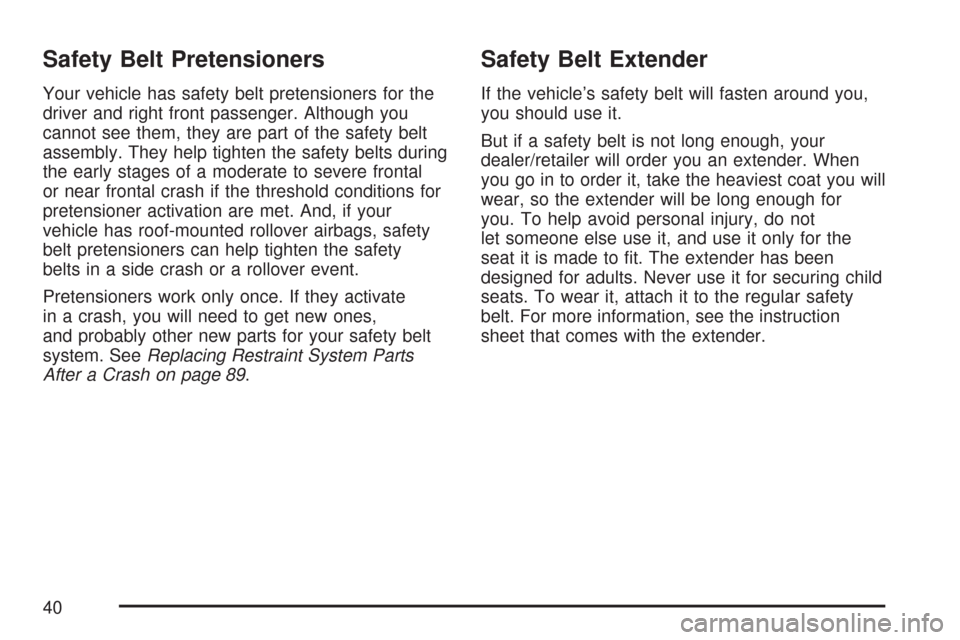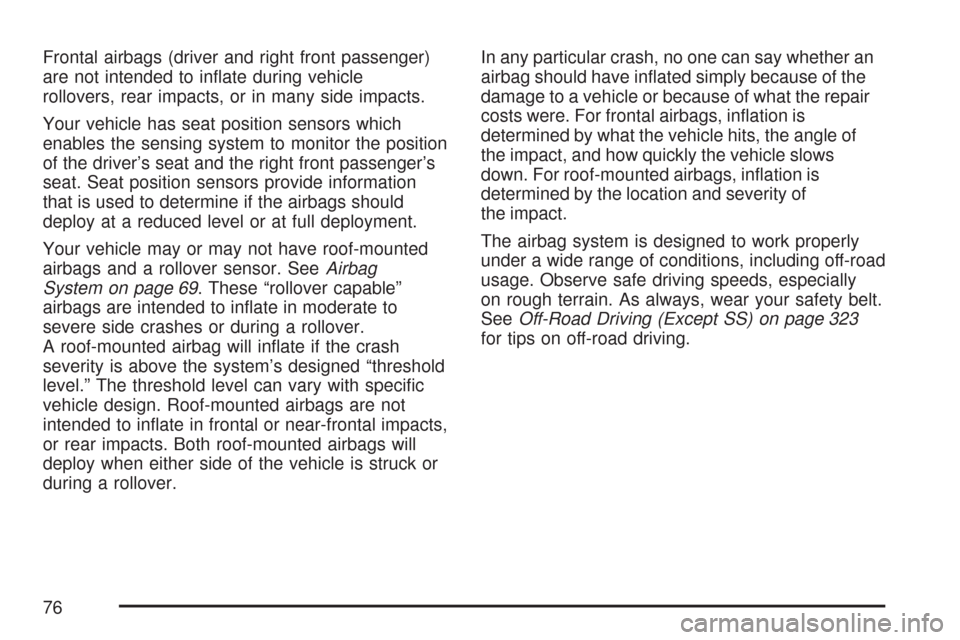2007 CHEVROLET TRAIL BLAZER roof
[x] Cancel search: roofPage 1 of 574

Seats and Restraint Systems
....................... 7
Front Seats
.............................................. 9
Rear Seats
............................................. 18
Safety Belts
............................................ 20
Child Restraints
...................................... 41
Airbag System
........................................ 69
Restraint System Check
......................... 88
Features and Controls
................................ 91
Keys
....................................................... 93
Doors and Locks
.................................... 98
Windows
............................................... 105
Theft-Deterrent Systems
....................... 108
Starting and Operating Your Vehicle
....... 111
Mirrors
.................................................. 132
OnStar
®System
................................... 145
Universal Home Remote System
.......... 149
Storage Areas
...................................... 161
Sunroof
................................................ 166Instrument Panel
....................................... 167
Instrument Panel Overview
................... 170
Climate Controls
................................... 187
Warning Lights, Gages,
and Indicators
................................... 198
Driver Information Center (DIC)
............ 220
Audio System(s)
................................... 238
Driving Your Vehicle
................................. 305
Your Driving, the Road, and
Your Vehicle
..................................... 306
Towing
................................................. 362
Service and Appearance Care
.................. 383
Service
................................................. 386
Fuel
...................................................... 388
Checking Things Under the Hood
......... 394
All-Wheel Drive
..................................... 438
Rear Axle
............................................. 438
2007 Chevrolet TrailBlazer Owner ManualM
1
Page 40 of 574

Safety Belt Pretensioners
Your vehicle has safety belt pretensioners for the
driver and right front passenger. Although you
cannot see them, they are part of the safety belt
assembly. They help tighten the safety belts during
the early stages of a moderate to severe frontal
or near frontal crash if the threshold conditions for
pretensioner activation are met. And, if your
vehicle has roof-mounted rollover airbags, safety
belt pretensioners can help tighten the safety
belts in a side crash or a rollover event.
Pretensioners work only once. If they activate
in a crash, you will need to get new ones,
and probably other new parts for your safety belt
system. SeeReplacing Restraint System Parts
After a Crash on page 89.
Safety Belt Extender
If the vehicle’s safety belt will fasten around you,
you should use it.
But if a safety belt is not long enough, your
dealer/retailer will order you an extender. When
you go in to order it, take the heaviest coat you will
wear, so the extender will be long enough for
you. To help avoid personal injury, do not
let someone else use it, and use it only for the
seat it is made to �t. The extender has been
designed for adults. Never use it for securing child
seats. To wear it, attach it to the regular safety
belt. For more information, see the instruction
sheet that comes with the extender.
40
Page 69 of 574

Airbag System
Your vehicle has a frontal airbag for the driver and
a frontal airbag for the right front passenger.
Your vehicle may also have roof-mounted side
impact airbags designed for either side impact or
rollover deployment. Roof-mounted side impact
airbags are available for the driver and the
passenger seated directly behind the driver and
for the right front passenger and the passenger
seated directly behind that passenger.
If your vehicle has roof-mounted side impact
airbags, the word AIRBAG will appear on
the airbag covering on the sidewall trim near the
driver’s and right front passenger’s window.
Even if you have no right front passenger seat in
your vehicle there is still an active frontal airbag
in the right side of the instrument panel. Do not
place cargo in front of this airbag.{CAUTION:
Be sure that cargo is not near an airbag.
In a crash, an in�ating airbag might force
that object toward a person. This could
cause severe injury or even death.
Secure objects away from the area in
which an airbag would in�ate. For more
information, seeWhere Are the Airbags?
on page 72andLoading Your Vehicle on
page 356.
Airbags are designed to supplement the protection
provided by safety belts. Even though today’s
airbags are also designed to help reduce the risk
of injury from the force of an in�ating bag, all
airbags must in�ate very quickly to do their job.
69
Page 70 of 574

Here are the most important things to know about
the airbag system:
{CAUTION:
You can be severely injured or killed in a
crash if you are not wearing your safety
belt — even if you have airbags. Wearing
your safety belt during a crash helps
reduce your chance of hitting things
inside the vehicle or being ejected from it.
Airbags are “supplemental restraints” to
the safety belts. All airbags are designed
to work with safety belts but do not
replace them.
Frontal airbags for the driver and right
front passenger are designed to deploy in
moderate to severe frontal and near frontal
crashes. They are not designed to in�ate in
CAUTION: (Continued)
CAUTION: (Continued)
rollover, rear crashes, or in many side
crashes. And, for some unrestrained
occupants, frontal airbags may provide
less protection in frontal crashes than
more forceful airbags have provided in
the past.
Roof-mounted side impact airbags are
designed to in�ate in moderate to severe
crashes where something hits the side of
your vehicle. They are not designed to
in�ate in frontal or in rear crashes. If the
vehicle is equipped with rollover capable
airbags, it has been designed to deploy
the roof-mounted side impact airbags in
the event of a vehicle rollover. Everyone
in your vehicle should wear a safety belt
properly — whether or not there is an
airbag for that person.
70
Page 71 of 574

{CAUTION:
Both frontal and roof-mounted side impact
airbags in�ate with great force, faster than
the blink of an eye. If you are too close to
an in�ating airbag, as you would be if you
were leaning forward, it could seriously
injure you. Safety belts help keep you in
position for airbag in�ation before and
during a crash. Always wear your safety
belt even with frontal airbags. The driver
should sit as far back as possible while
still maintaining control of the vehicle.
Occupants should not lean on or sleep
against the door.
{CAUTION:
Anyone who is up against, or very close
to, any airbag when it in�ates can be
seriously injured or killed. Airbags plus
lap-shoulder belts offer the best
protection for adults, but not for young
children and infants. Neither the vehicle’s
safety belt system nor its airbag system is
designed for them. Young children and
infants need the protection that a child
restraint system can provide. Always
secure children properly in your vehicle.
To read how, seeOlder Children on
page 41orInfants and Young Children on
page 44.
71
Page 73 of 574

The right front passenger’s frontal airbag is in the
instrument panel on the passenger’s side.If your vehicle has a roof-mounted airbag for the
driver and the person seated directly behind
the driver, it is located in the ceiling above the
side windows.
73
Page 74 of 574

If your vehicle has a roof-mounted airbag for the
right front passenger and the person directly
behind that passenger, it is located in the ceiling
above the side windows.
{CAUTION:
If something is between an occupant and
an airbag, the bag might not in�ate
properly or it might force the object into
that person causing severe injury or even
death. The path of an in�ating airbag must
be kept clear. Do not put anything
between an occupant and an airbag, and
do not attach or put anything on the
steering wheel hub or on or near any
other airbag covering. And, if your vehicle
has roof-mounted side impact airbags,
never secure anything to the roof of your
vehicle by routing the rope or tie down
through any door or window opening.
If you do, the path of an in�ating side
impact airbag will be blocked. The path of
an in�ating airbag must be kept clear.
74
Page 76 of 574

Frontal airbags (driver and right front passenger)
are not intended to in�ate during vehicle
rollovers, rear impacts, or in many side impacts.
Your vehicle has seat position sensors which
enables the sensing system to monitor the position
of the driver’s seat and the right front passenger’s
seat. Seat position sensors provide information
that is used to determine if the airbags should
deploy at a reduced level or at full deployment.
Your vehicle may or may not have roof-mounted
airbags and a rollover sensor. SeeAirbag
System on page 69. These “rollover capable”
airbags are intended to in�ate in moderate to
severe side crashes or during a rollover.
A roof-mounted airbag will in�ate if the crash
severity is above the system’s designed “threshold
level.” The threshold level can vary with speci�c
vehicle design. Roof-mounted airbags are not
intended to in�ate in frontal or near-frontal impacts,
or rear impacts. Both roof-mounted airbags will
deploy when either side of the vehicle is struck or
during a rollover.In any particular crash, no one can say whether an
airbag should have in�ated simply because of the
damage to a vehicle or because of what the repair
costs were. For frontal airbags, in�ation is
determined by what the vehicle hits, the angle of
the impact, and how quickly the vehicle slows
down. For roof-mounted airbags, in�ation is
determined by the location and severity of
the impact.
The airbag system is designed to work properly
under a wide range of conditions, including off-road
usage. Observe safe driving speeds, especially
on rough terrain. As always, wear your safety belt.
SeeOff-Road Driving (Except SS) on page 323
for tips on off-road driving.
76